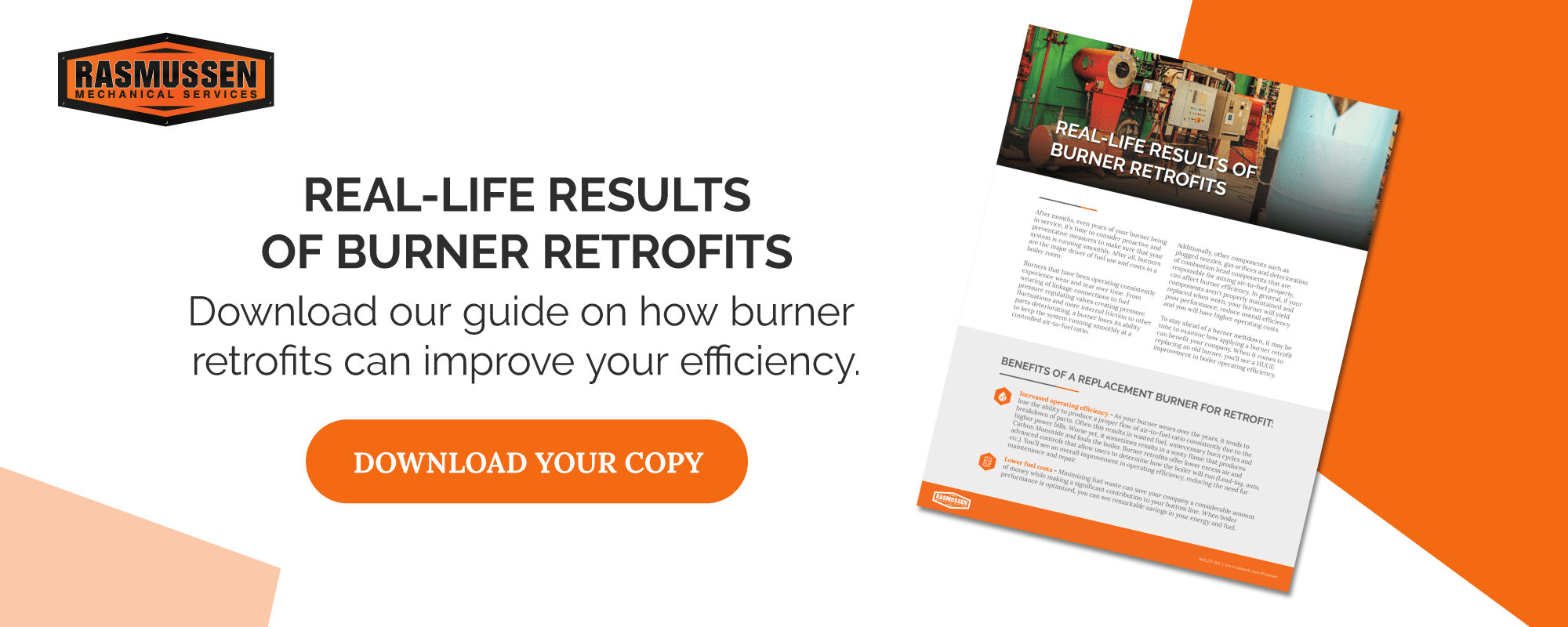When it comes to selecting an industrial burner, there are many variables to consider. Of course, you’ll need to identify what capacity and what flame you will need. You’ll also need to think about temperature requirements, burner rating and more.
Our experts have collected their ten most valuable tips for industrial burner selection.
BURNER SELECTION TIP #1: UNDERSTAND BURNER RATING
First and foremost, consider the burner rating. If a burner is rated too small, then your system may not be able to reach your desired temperature or capacity. You’ll want to look for a burner that has a higher maximum input rating than your equipment maximum firing rate.
BURNER SELECTION TIP #2: DETERMINE TURNDOWN
Turndown ratio, the ratio of maximum capacity to the minimum capacity, shows the flexibility of a burner. If you’re looking for a burner that can handle a variety of different load profiles, search for a burner with a larger turndown ratio. This will avoid cycling. Excessive burner cycling adds wear and tear to components and can lead to excessive purge loss. As process turndown can vary significantly, ensure that your final choice will allow you to operate at both your smallest and largest load.
BURNER SELECTION TIP #3: MINIMIZE EXCESS AIR
Excess air reduces efficiency but is required for good mixing, clean combustion, and low emissions of CO. Typical burners are rated according to excess oxygen measured at the stack as a percentage (%O2). 3% O2 is the same as 15% excess air, and this is a good target for most industrial applications.
While many manufacturers guarantee emissions at 3% O2 at high fire, many burners begin to use additional excess air as the burner turns down. Be wary of burners promising ‘efficient’ turndown at ratios in excess of 10:1 as this may be utilizing a LOT of excess air. Consider an 8:1 burner at 3% O2, cycling a couple of times an hour to keep a system at temperature during off hours. This is generally more efficient than a burner with 20:1 turndown that never cycles but has as much as 75% excess air.
Turndown and excess air are a trade-off. Your load profile is an important factor in determining which burner is right for you. Choosing the correct burner for your operation is crucial for operational efficiency and the life of your equipment.
BURNER SELECTION TIP #4: CONSIDER THE INSTALLATION
Take the ease of mounting, access, and adjustment into consideration when selecting your burner. The burner mounting should allow for removal of the head and access to other important parts. This will prevent you from having to disassemble the burner completely, remove wiring, or move other equipment. Some burners require the installation of hefty refractory monoliths that are difficult to install and maintenance intensive.
BURNER SELECTION TIP #5: FUEL TYPE
When selecting a new burner system, weigh the pros and cons of each of the following fuels:
- Natural gas. Natural gas is the most commonly used gas for boiler systems. It is often the least expensive fuel and readily available to those located near a line.
- Fuel oil. Often, many owners choose fuel because they do not have natural gas service, or intend to use fuel oil as a backup. Transporting oil to the facility, however, can be pricey and you’ll pay more per BTU.
- Liquid propane. Liquid propane, although more expensive than natural gas, is widely available and an inexpensive alternative. This gas type produces fewer emissions, and for that reason, is considered a cleaner method. On large systems, propane requires the use of a vaporizer, which will add cost and complexity.
- No gas (Electric). Electric heating methods are often more expensive than gas methods. They are, however, clean, quiet, and easy to use.
BURNER SELECTION TIP #6: O2 TRIM
When selecting a burner, our experts recommend looking for a control system that has an oxygen (O2) trim function. Oxygen trim utilizes a monitoring system that typically measures oxygen and CO to adjust airflow. Essentially, the system measures and maintains an optimum air to fuel ratio all the time. An O2 trim system can sometimes be added to a burner at a later date. However, it is more cost-effective to install O2 trim during the burner install process. Often times O2 trim pays for itself very quickly and it adds a layer of combustion safety to your system.
BURNER SELECTION TIP #7: INSTALL A VARIABLE FREQUENCY DRIVE
When installing a new burner, it is an ideal time to fit the forced draft fan with a Variable Frequency Drive (VFD). A VFD is a great idea for any burner system, especially one that is not going to run at full load all the time. A VFD:
- Increases motor life by reducing starting amps
- Significantly reduces fan power consumption due to fan affinity laws
- Makes the burner easier to control due to lower fan pressure as the burner turns down.
BURNER SELECTION TIP #8: CONSULT WITH A BURNER SPECIALIST
As the selection process becomes more difficult, talk to a burner specialist to get recommendations on a system. If you questions about burner rating, O2 Trim, Turndown or excess air just reach out.
At Rasmussen Mechanical Services, we know burners. Give us a call at 1-800-237-3141 or chat with us to discuss your burner selection or maintenance needs. Our experts will be on standby waiting to help you.




